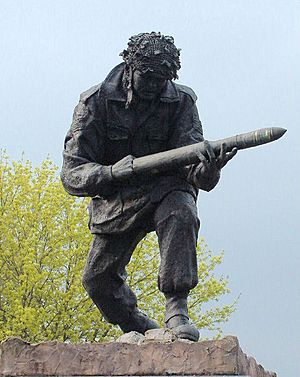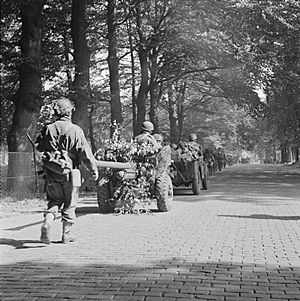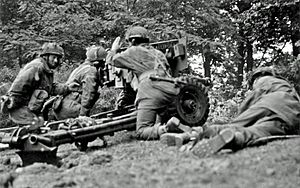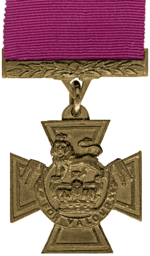John Baskeyfield facts for kids
Quick facts for kids
John Baskeyfield
|
|
|---|---|

John Baskeyfield memorial statue at Festival Heights in Stoke-on-Trent, Staffordshire.
|
|
| Born | 18 November 1922 Burslem, Stoke-on-Trent, Staffordshire, England |
| Died | 20 September 1944 (aged 21) Oosterbeek, Netherlands |
| Allegiance | United Kingdom |
| Service/ |
British Army |
| Years of service | 1942–1944 |
| Rank | Lance sergeant |
| Service number | 5057916 |
| Unit | South Staffordshire Regiment |
| Battles/wars | |
| Awards | Victoria Cross |
John Daniel Baskeyfield VC (born 18 November 1922 – died 20 September 1944) was a brave soldier in the British Army. He received the Victoria Cross (VC), which is the highest award for courage a soldier can get in the face of the enemy. It's given to members of the British and Commonwealth armed forces.
John Baskeyfield was born in 1922. He joined the British Army in 1942. He served with the 2nd Battalion, South Staffordshire Regiment. This unit was part of the 1st Airborne Division. He fought in Sicily and Italy in 1943. After that, he returned to the United Kingdom.
Later, his division was sent to the Netherlands for Operation Market Garden. They fought in the Battle of Arnhem. During this battle, Baskeyfield was in charge of two anti-tank guns. He destroyed several enemy tanks even after his team was killed. He kept firing the guns alone until he was also killed. His body was never found after the war.
Contents
Early Life and Joining the Army
John Baskeyfield was born on 18 November 1922 in Burslem, Stoke-on-Trent, England. His parents were Daniel and Minnie Baskeyfield. Before the war, he trained and worked as a butcher. When he was 19, in February 1942, he was called to join the army.
Early Military Service
Baskeyfield joined the South Staffordshire Regiment. He was part of the 2nd Battalion's anti-tank team. This battalion was part of the 1st Airlanding Brigade. This brigade was part of the 1st Airborne Division.
In 1943, Baskeyfield went with his division to North Africa. From there, they took part in Operation Ladbroke. This was a glider-borne attack during the Invasion of Sicily. After Sicily, the division landed in Italy for Operation Slapstick. They fought their way through Italy for several weeks. Then, they sailed back to England.
The Battle of Arnhem
The Battle of Arnhem was a big part of Operation Market Garden. This operation aimed to capture a series of bridges in the Netherlands. At Arnhem, the British 1st Airborne Division and Polish 1st Independent Parachute Brigade had to secure bridges over the Lower Rhine river. These were the last bridges needed for the operation.
However, the Allied forces who landed on 17 September didn't know that two strong German tank divisions were also near Arnhem. These German forces had many tanks and self-propelled guns. This made the battle much harder for the Allies. Only a small group of British soldiers managed to hold one end of the Arnhem road bridge. But they were eventually defeated on 21 September. The rest of the division got stuck in a small area west of the bridge. They had to be rescued on 25 September in Operation Berlin. The Allies failed to cross the Rhine, and the Germans kept control of it until March 1945.
Fighting in Arnhem
Because there weren't enough aircraft, the Allies planned to fly the entire division to Arnhem over three days. The South Staffordshire Battalion arrived over two days. Their anti-tank guns arrived on the first day.
The original plan was for the 1st Airlanding Brigade to secure the landing zones. But by the end of the first day, the Allied advance into Arnhem had stopped. Only a small group of soldiers reached the bridge. The other battalions couldn't get through the city's outer areas. So, the first part of the South Stafford's was sent forward on 18 September to help. When the second part arrived later that day, they also went forward. The South Staffordshire's anti-tank team stayed in the main division area.
In the early morning of 19 September, an attack was launched to reach the bridge. Most of the heavy weapons were left behind because it was dark and the city streets were narrow. But the Germans had strong positions and tanks. The British attack failed, and they were forced to retreat.
Retreat to Oosterbeek
The remaining soldiers fell back in confusion to the main division positions in Oosterbeek. Here, they were gathered into defensive groups. Major Robert Cain helped form them into a defensive line. This area was called "Thompson Force."
On 20 September, German forces launched strong attacks against this force. John Baskeyfield was in charge of two 6 pounder anti–tank guns. They were defending a crossroads on the Benedendorpsweg, a road between Arnhem and Oosterbeek. Baskeyfield's guns faced the Acacialaan, a road joining from the north. This covered the likely enemy approach.
In the first German attack, Baskeyfield and his team destroyed two tanks and a self-propelled gun. Baskeyfield waited until the enemy tanks were very close, about 100 yards away, before ordering his team to fire. Other British soldiers in nearby houses dealt with the attacking German infantry. During this fight, Baskeyfield's team was killed or wounded. Baskeyfield himself was badly hurt.
However, he refused to leave. In a later German attack, he worked his gun all by himself. He loaded, aimed, and fired it alone. He kept firing until his gun was destroyed. Then, he crawled to the second gun, whose team was also out of action. From there, he attacked another self-propelled gun. He destroyed it with two shots. But he was killed shortly after by fire from another German tank.
The British forces later moved back to new positions. They continued to hold the Oosterbeek area until the Allies left in Operation Berlin on the night of 25 September.
Victoria Cross Award
John Baskeyfield was awarded the Victoria Cross for his incredible bravery. The official announcement was made on 23 November 1944.
It said that on 20 September 1944, during the Battle of Arnhem, Lance-Sergeant Baskeyfield was in charge of an anti-tank gun. The enemy launched a huge attack with infantry, tanks, and self-propelled guns. They wanted to break through the British lines.
At the start of the battle, Baskeyfield's team destroyed two tanks and at least one self-propelled gun. He was very calm and daring. He let each tank come within 100 yards of his gun before firing. This showed he was not afraid.
During this first fight, Baskeyfield was badly wounded in the leg. The rest of his team were either killed or badly wounded. Even though he was hurt, Baskeyfield refused to be taken to get medical help. He spent his time checking his gun and encouraging his friends in nearby trenches.
After a short break, the enemy attacked again, even more fiercely. They fired many mortars and shells. Baskeyfield, all alone, kept firing round after round at the enemy. He kept the enemy tanks away. His amazing example and courage kept the other soldiers fighting. Time after time, enemy attacks were launched and pushed back.
Finally, when his gun was destroyed, Baskeyfield crawled under heavy enemy fire to another anti-tank gun nearby. Its crew had been killed. He started to use this gun by himself. He fired at an enemy self-propelled gun that was coming closer. Another soldier tried to help him but was killed almost immediately. Baskeyfield managed to fire two shots at the self-propelled gun, hitting it directly and stopping it. But as he was getting ready to fire a third shot, he was killed by a shell from another German tank.
His bravery was beyond praise. For the rest of the days at Arnhem, stories of his courage inspired everyone. He ignored danger and pain. His amazing fighting spirit made everyone around him just as determined and brave.
Legacy and Remembrance
After Arnhem was freed in April 1945, British teams looked for the Allied soldiers who had died. Over 1700 men were buried in the Arnhem Oosterbeek War Cemetery. However, John Baskeyfield's body was never found. His name is written on the Groesbeek Memorial. This memorial remembers all Allied soldiers killed between August 1944 and the end of the war who have no known grave.
Four more Victoria Crosses were given after the battle, including one to Major Robert Cain. This meant the 2nd Battalion became the only British battalion to receive two VCs in one battle during the Second World War.
John Baskeyfield's Victoria Cross medal is on display at the Staffordshire Regiment Museum in Whittington, Staffordshire. A large statue of him was built in 1990 at Festival Heights in Stoke-on-Trent. A primary school in Burslem was named after him, but it was renamed Saint Nathaniel's Academy in 2014.
Baskeyfield is also remembered by a retirement community called Baskeyfield House in Burslem. An Army Reserve Centre in Stoke on Trent is also named Baskeyfield House. The artist Terence Cuneo painted a picture of Baskeyfield's brave actions. In 1969, a filmmaker made a short movie about his role in the battle, called Baskeyfield VC. A tree at the spot where Baskeyfield fought his second gun is named the Jack Baskeyfield Tree.
See also
- List of Second World War Victoria Cross recipients
Four other men received the Victoria Cross at Arnhem:
- Major Robert Henry Cain, 2nd Battalion South Staffordshire Regiment.
- Lieutenant John Hollington Grayburn, 2nd Battalion Parachute Regiment.
- Flight Lieutenant David Samuel Anthony Lord, 271 Squadron, Royal Air Force.
- Captain Lionel Ernest Queripel, 10th Battalion Parachute Regiment.




